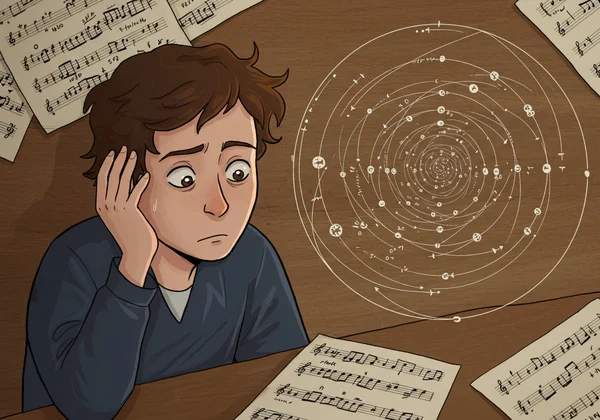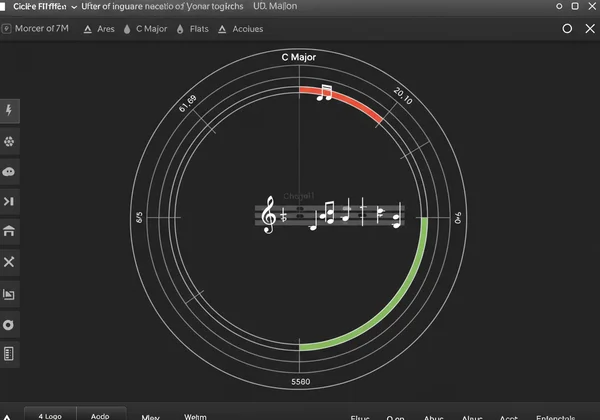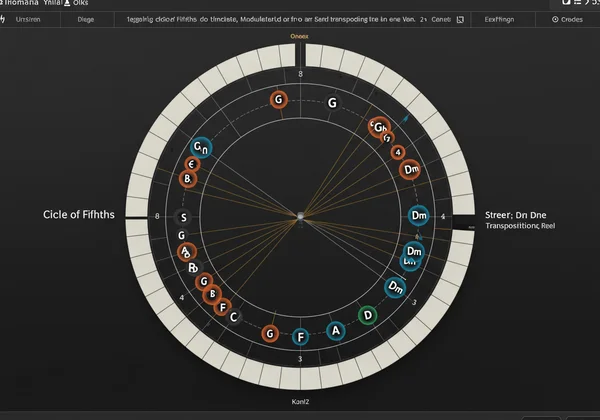精通五度圈:您的互动乐理解决方案
您是否在为理解 五度圈 而苦恼?许多初学者觉得这个基础的乐理概念令人望而生畏,并因此犯下阻碍进步的常见错误。 如何有效地使用五度圈 ,而不是迷失在升降号的迷宫中?有没有一种更简单的方法来掌握它?本文将揭示最常见的陷阱,并展示我们的互动工具 CircleOfFifths.io 如何提供即时清晰的解释和纠正,从而彻底改变您对音乐关系的理解。
应避免的常见五度圈错误
五度圈是一个强大的工具,但许多学生常常在此跌倒。认识到这些常见的理论失误是迈向真正精通的第一步。无论您是乐理学生、有抱负的词曲作者,还是乐器演奏者,这些 乐理理解上的障碍 常常阻碍您的进步。

误解调号的顺序(升降号)
最常见的 五度圈错误 之一是混淆调号中升降号的顺序。许多人试图死记硬背(升号的 F-C-G-D-A-E-B,降号的 B-E-A-D-G-C-F),而没有理解它们在五度圈本身上的位置。这会导致在快速识别调性或 构建音阶 时遇到困难。如果没有清晰的视觉指南,记住某个调性有多少个临时记号,甚至这些临时记号在五线谱上的位置,都可能感觉像是在猜测。这个基础性的错误会 严重影响 您整个 学习乐理 的旅程。
混淆大调与关系小调的关系
五度圈 清晰地展示了 大调与其 关系小调 之间的关系。然而,许多学习者在 快速识别 这些配对时遇到困难。他们可能知道 C 大调与 A 小调相关,但当遇到降 E 大调时,他们可能无法立刻回想起其关系小调,即 C 小调。这种混淆使得理解和声进行变得困难,并可能限制您创作或即兴创作的能力。 调式 之间的 平稳过渡 往往取决于对这些基本联系的掌握。
忽略自然和弦的功能
除了调号之外,五度圈还揭示了任何给定调性中可用的 自然和弦。一个常见的疏忽是未能理解每个和弦在进行中的功能,或者 不清楚 哪些和弦属于某个特定的调性。例如,知道 G 大调的和弦有哪些 不仅仅是列出 G、C 和 D;而是要理解为什么 D 是属和弦,以及它如何 导向 G 和弦。没有这些见解,创作 富有吸引力的 和弦进行 就会变成随机的练习,而不是一个合乎逻辑的、富有创造性的过程。这是 初学者乐理方面的支持 中一个常常被忽视的重要方面。
在转调和调性转换中遇到困难
对于词曲作者和乐器演奏者来说,五度圈在 转调 和 调性转换 方面非常有价值。然而,许多人发现这些应用令人望而生畏。将一首歌曲从一个调性转移到另一个调性(转调),或在歌曲中平稳地在不同调性之间移动(调性转换),似乎是高级技巧。选择“错误”的调性或进行 不自然的调性转换 的恐惧常常阻止音乐家们探索这些创造性的途径。这是 五度圈解释 视觉化可以产生巨大影响的一个主要领域。
将其视为静态图表而非互动工具
也许最大的 五度圈错误 是将它仅仅视为教科书中的静态图表或墙上的 五度圈图表。虽然这些视觉元素提供了基本概述,但它们缺乏真正理解所需的动态反馈。乐理不仅仅是记忆;它是关于理解关系并听出它们在实践中的应用。静态图表无法向您展示和弦听起来如何,或者改变一个调性如何瞬间重构所有相关的元素。
我们的互动工具如何澄清五度圈的困惑
在我们的互动平台上,我们设计了该工具来直接解决这些常见问题。我们的互动式 在线工具 将五度圈的抽象概念转化为一种动态、引人入胜且极其有效的学习体验。对于任何认真 学习乐理 的人来说,这是一个不可或缺的 互动资源。请随时 探索我们的互动工具!
即时可视化调号及其顺序
告别死记硬背。我们的工具允许您点击五度圈中的任何一个调,它会立即在顶部显示其相应的调号(升降号)。您将立即看到升降号的确切数量和顺序,从而 轻松形成视觉关联。此功能使理解 调号 变得直观,并消除了关于升降号顺序的烦人误解。

一键揭示关系小调的联系
只需单击一个大调,我们的工具就会突出显示其 关系小调,向您展示直接关系。不再需要猜测或尝试记住公式。这种 清晰的视觉呈现 增强了您对调式关系的理解,并为创作和分析音乐 带来了新的可能。我们的平台通过明确这些联系,提供快速、可靠的 初学者乐理方面的支持。
通过音频示例和详细信息探索自然和弦
想知道 F 大调的和弦有哪些 吗?点击我们五度圈上的“F”,该工具将显示该调性中所有的 自然和弦,以及它们的功能(例如,主和弦、属和弦)。但还有更好的:您可以单击每个和弦来听听它的声音!想象一下让乐理活起来!我们的音频反馈彻底改变了您的理解,即时将抽象概念与 实际的音乐声音 联系起来。这不仅仅是关于记忆;更是关于增强您的音乐听觉,并让您的和弦进行 更加流畅。
通过互动高亮简化转调和调性转换
我们的互动式 五度圈 工具使 转调 和 调性转换 变得轻而易举。通过点击不同的调,您可以立即看到 音乐关系 如何变化,从而轻松可视化常见的枢轴点或识别用于平滑过渡的新调。这种 互动式高亮提示 有助于您自信地尝试在创作中进行调性转换,或 根据乐器音域调整歌曲。对于任何希望提高能力的乐器演奏者来说,这是一个极好的资源。

通过练习和自我测试功能实现精通
除了给出答案之外,我们的工具还鼓励 主动参与 学习乐理。您可以隐藏调号来测试您的知识,或者在 G 谱号和 F 谱号之间切换。这个 视觉指南 不仅仅用于查找信息;它是一个动态的练习平台,帮助您建立信心并真正掌握五度圈。无论您是学生还是经验丰富的音乐家,这些功能都旨在 促进深入学习。您甚至可以将 五度圈图 导出为 PDF 以供离线学习,确保您的学习永不停止。准备好 精通乐理 了吗?立即 尝试我们的免费工具!
释放您的音乐潜能
不要让常见的 五度圈 错误阻碍您的音乐之旅。通过正确的方法和我们在线工具的力量,掌握这个基本概念将触手可及。我们的互动工具旨在简化复杂的乐理挑战,为您提供即时的清晰度和实际应用。无论您是在为调号、关系小调还是和弦功能而苦恼,我们的平台都提供了全面而引人入胜的解决方案。

那么,您准备好停止挣扎,开始创作了吗?今天就深入了解 CircleOfFifths.io,亲身体验解锁和声秘密是多么轻松。 您的音乐潜能正待您挖掘 ——让我们的工具帮助您释放它!
关于五度圈的常见问题解答
如何有效地使用五度圈?
要有效地使用五度圈,请与之互动!不要只看静态图表。我们位于 CircleOfFifths.io 的工具允许您点击调性,查看其对应的调号、关系小调和 自然和弦。尝试不同的调性并聆听和弦,以培养对 音乐各要素之间的关系 的直观理解。
五度圈主要用于什么?
五度圈主要用于理解 调号、识别 关系小调、探索某个调性中的 和弦进行,以及在音乐中促进 转调 和 调性转换。它是创作、即兴创作和分析音乐的 必不可少的工具。
有没有快速记忆五度圈的方法?
记忆五度圈最简单的方法是通过视觉和互动学习。与其仅仅记忆名称,不如使用我们的互动工具,它会向您展示关系并 供您练习。这种 主动参与 使过程比传统的死记硬背更加直观。
五度圈能帮助找到歌曲的调性吗?
是的,五度圈绝对可以帮助找到歌曲的调性。通过分析歌曲中使用的主要和弦,特别是主和弦(I)和属和弦(V),您通常可以在五度圈上 确定调性。我们的工具通过显示任何给定调性的 组成和弦 来协助这种分析。
如何使用五度圈找到某个大调的和弦?
要使用五度圈找到 A 大调的和弦有哪些 (或任何其他调性),只需导航到 CircleOfFifths.io 并点击所需的调性。我们的互动工具将立即显示该调性的所有 组成和弦 (I、ii、iii、IV、V、vi、vii°)以及听取它们的声音的选项。这种清晰性消除了关于 和弦构成 的任何常见理论错误。